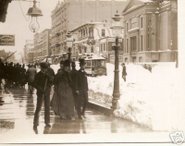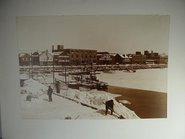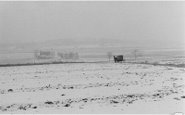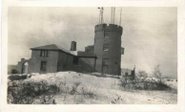Sudden Stratospheric Warming - Mother Lode of Cold
 Vortex reversal @ 10 mb was observed around JAN 27. Easterlies propagated steadily through 30...50...70...and close to 100 mb at post time. Warming has reached the tropopause near 300 mb.
Vortex reversal @ 10 mb was observed around JAN 27. Easterlies propagated steadily through 30...50...70...and close to 100 mb at post time. Warming has reached the tropopause near 300 mb.
Given there/s ~3-4 week lag between SSW-onset and its effects affecting the troposphere...LR progs are beginning to suggest the magnitude of the cold mother lode and the location where it will be observed.
Note the cold temperatures at 90°N in the D+10 latitude-height cross section. Top-o-world 1000 mb temperature -30°C! (-22°F) Coldest forecast temperature this winter. The warm bubble over 90°N @ 200 mb is the remnant of descending warm stratospheric air. Note the slope of the temperature gradient between 80°N and 90°N near 500 mb...evidence of an arctic jet.  The North Atlantic Oscillation (NAO) plunges...accordingly. 5 to 7 standard deviations below normal. Wowser! Should NAO come anywhere near those levels...it would be abso-fookin' historic. The lowest daily NAO value from a CPC dataset beginning in 1950 is -3.254.
The North Atlantic Oscillation (NAO) plunges...accordingly. 5 to 7 standard deviations below normal. Wowser! Should NAO come anywhere near those levels...it would be abso-fookin' historic. The lowest daily NAO value from a CPC dataset beginning in 1950 is -3.254. 
The always reliable D+14 GooFuS blocking forecast suggests mega-blocking over Baffin Bay / Greenland....with significant winter weather implications for the eastern CONUS.
Apparently...Meteorlogix in Woburn...MA didn't get the memo until today.
From the JAN 28th edition of the Nashua Telegraph...Different story today...
"I do not see significant changes in the overall pattern we've had," Doug Webster of Hudson, senior meteorologist with Meteorlogix said.
If that's the bad news for the rest of winter, the good news is that Webster doesn't see us having another "severe cold snap" like the one that hit last week."
Doug Webster...
"The outlook for the remainder of the winter and early spring could hinge on recent events many miles above the polar landscape. During the end of January, an event known as Sudden Stratospheric Warming took place.
[...]
"Past history (ed. Is there any onther kind?) shows that when strong SSW occurs, wintry weather expands southward into the mid latitudes around the globe for a one- to two-month period.
[...]
"Given these possibilities, wintry weather could again become a fairly big story across much of the nation later this winter and into the spring.
"Past research (ed. Is there any other kind?) shows the lag time for the start of the more wintry weather regime is apparently on the order of two to three weeks after the SSW event. So enjoy the milder weather of the next week or so, because winter may return with some force during the second half of February and beyond."























No comments:
Post a Comment